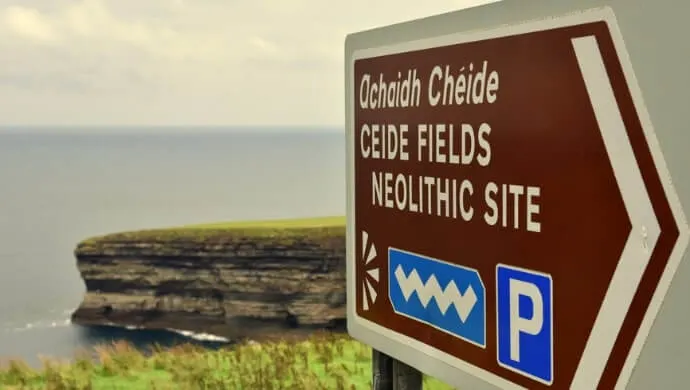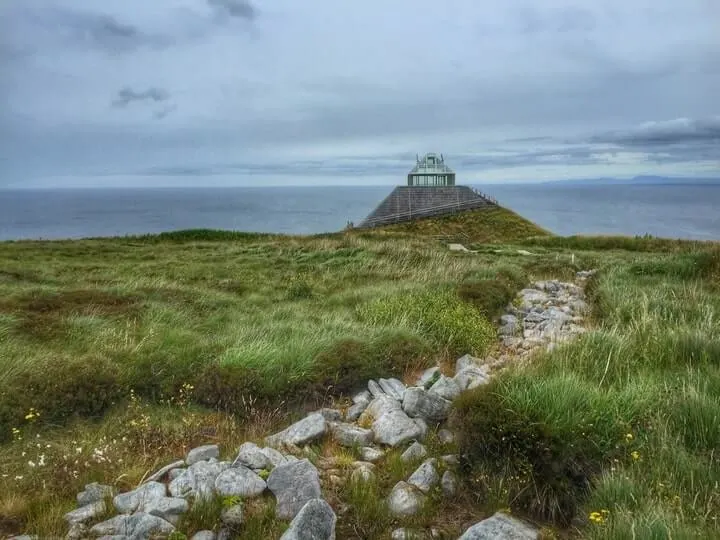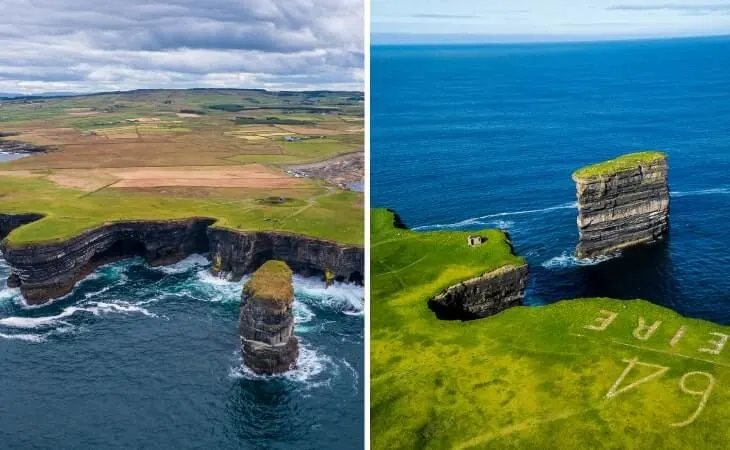I’d argue that a visit to the Ceide Fields is one of the most overlooked things to do in Mayo.
The Ceide Fields are a remarkable neolithic site standing on limestone and shale cliffs 113 metres above the Atlantic Ocean in County Mayo.
They are thought to be the oldest-known field system in the world and were discovered by accident in the 1930s.
In the guide below, you’ll discover everything you need to know about visiting the Ceide Fields in Mayo, from how much tickets cost to what to see nearby.
Some quick need-to-knows before visiting the Ceide Fields in Mayo

Photo by Alexander Narraina (Shutterstock)
Although a visit to the Ceide Fields is fairly straightforward, there are a few need-to-knows that’ll make your visit that bit more enjoyable.
1. Location
Located on the north coast of County Mayo, the Ceide Fields is a Signature Discovery Point on the Wild Atlantic Way. With dramatic views of the Atlantic Ocean, this clifftop Neolithic site is 14km west of Downpatrick Head and 34km northwest of the town of Ballina.
2. A whole lot of history
We usually measure history in centuries, but the Ceide Fields date back 6,000 years to around 4,000 BCE. The site is on cliffs that are even older – estimated to be 300 million years old!
3. Oldest field system on earth
This extensive Stone Age monument is the oldest-known field system in the world. It includes megalithic tombs, stone-walled fields and dwellings preserved for millennia beneath blanket bogs. This Neolithic settlement was discovered by schoolteacher Patrick Caulfield in the 1930s while he was cutting peat.
4. Admission
Ceide Fields charges a modest admission of €5 for adults, €4 for seniors and €3 for students and children (prices may change).
5. Opening times
The Visitor Centre is open daily from mid-March to May 17; June 1st to September 18th and October 1st to November 17th. It is closed throughout the winter.
A speedy history of the Ceide Fields

Photo by draiochtanois (shutterstock)
I’ll never do the history of the Ceide Fields in Mayo justice with a handful of paragraphs – the section below is intended to give you a little insight into their past.
Who lived at Ceide Fields
Careful excavation reveals that the Ceide Fields site was home to a large community of farmers who cleared the area of pine forest.
They reared cattle, grew crops and were craftsmen in wood and stone. The bog shows evidence that the climate was much warmer at that time, around 4000BCE.
The discovery of the Ceide Fields
The Ceide Fields were discovered in the 1930s by local schoolteacher Patrick Caulfield when cutting peat for fuel. He uncovered clearly defined walls of stone buried beneath the blanket bogs.
The site was only fully investigated in the 1970s by Patrick’s son, Seamus*, a trained archaeologist. Investigations revealed a site of human habitation of unparalleled historical significance with walled fields and megalithic tombs.
*This father and son were the first to land by helicopter on Dun Briste sea stack and explore the remains of homes, fields and flora there.
Things to see and do at the Ceide Fields
One of the reasons you’ll often see us describing the Ceide Fields as one of the most overlooked places to visit in Mayo is down to the sheer number of things there is to see here.
1. The Visitor Centre
The modern Ceide Fields Visitor Centre opened in May 1993. It has award-winning architecture in a pyramid shape rising from the peat bog.
It was constructed from natural durable materials to complement the sensitive environment. It includes a glass observation tower which offers superb views across the archaeological site to the Atlantic Ocean and Stags of Broadhaven (islets).
The Visitor Centre has exhibits of geological, botanical and human history along with a 4,300-year-old Scots pine that was preserved in the bog. It also has a tea room for enjoying the wonderful clifftop setting.
2. The panoramic viewing platform
You can enjoy the Visitor Centre in all weathers as it has viewing platforms both indoors and outside on the glass-topped roof of the building. Both platforms offer dramatic views of the Ceide Fields site and the Atlantic Ocean from this breathtaking clifftop location.
3. Tours
As well as an audio-visual presentation, the Visitor Centre offers guided tours on pathways over the bog. Visitors can clearly see the walled fields, a domestic enclosure and a pen for animals.
Tours include a hands-on interactive experience using metal rods to poke down through the peat bog and feel the stone walls buried below.
You can also learn about the biodiversity of the bog with its mosses, lichens, orchids and bog plants. Learn how a Scots pine was preserved in the bog for over 4,300 years! You can also ask questions as part of the tour.
Things to do near the Ceide Fields
One of the beauties of the Ceide Fields is that it’s a short spin away from a clatter of other attractions, both man-made and natural.
Below, you’ll find a handful of things to see and do a stone’s throw from the Ceide Fields (plus places to eat and where to grab a post-adventure pint!).
1. Downpatrick Head

Photos by Wirestock Creators (Shutterstock)
Located on the Wild Atlantic Way, Downpatrick Head overlooks the famous Dun Briste sea stack just 220 metres offshore. There’s a large car park and seasonal coffee shop for visitors. The headland is the site of a ruined church, statue to St Patrick, WW2 lookout post and a spectacular blowhole, so plenty of reasons to visit!
2. The Mullet Peninsula

Photo by Paul Gallagher (Shutterstock)
The remote Mullet Peninsula is a well-hidden gem 47km west of Ceide Fields. Seemingly surrounded by ocean, it offers endless unspoiled scenery. The windswept, treeless landscape looks out across Broadhaven Bay to the east and the Atlantic Ocean to the west. Discover more in our guide to the best things to do in Belmullet.
3. Benwee Head

Photo by teddiviscious (shutterstock)
The steep quartzite cliffs, arches and chimneys at Benwee Cliffs have earned the nickname Yellow Cliffs, due to their odd colour. If you do the Benwee Loop walk you’ll be treated to remarkable views across Broadhaven Bay over the course of 5+ hours.
4. Belleek Castle

Photo by Bartlomiej Rybacki (Shutterstock)
Now a luxury hotel and award-winning restaurant, Belleek Castle is a magnificent Neo-Gothic manor built in 1825 for Sir Arthur Francis Knox-Gore at a cost of £10,000. Eventually abandoned, the ruin was bought in 1961 and restored by craftsman, smuggler and sailor Marshall Doran.
5. Belleek Woods
Enjoy walking or cycling along waymarked trails through Belleek Woods on the banks of the River Moy. Surrounding Belleek Castle, the 200-acre woodland is a natural haven with primroses, bluebells, foxgloves and wild garlic marking the seasons. Landmarks include the Knox-Gore Monument, known as the “Horse’s Grave”, and the stranded concrete boat.
FAQs about visiting the Ceide Fields in Mayo
We’ve had a lot of questions over the years asking about everything from how old are they to what there is to see.
In the section below, we’ve popped in the most FAQs that we’ve received. If you have a question that we haven’t tackled, ask away in the comments section below.
How old are the Ceide Fields?
As crazy as it may seem, they’re a whopping 6,000+ years old.
Are they really worth a visit?
Yes, if you’re exploring the North Mayo coast, they’re definitely worth having a nosey around, as they’re packed with history to discover.
What is there to see at the Ceide Fields?
You can step back in time at the visitor centre, soak up the scenery from the panoramic viewing platform and you can also head off on a guided tour.

Peter Morley
Wednesday 7th of September 2022
It costs Euro 5 to enter and it is a complete waste of time and money. There are hardly any walls and the few there are at ground level. Very little is known about them and therefore the information center can't tell you anything about them.
Colette Kelly
Friday 1st of October 2021
Thank you, succinct, interesting, factual information. I absolutely agree with previous comment. Thank you.
Keith O'Hara
Friday 1st of October 2021
Thanks Colette. Enjoy your visit!
Mr Laurence Hattersley
Saturday 4th of September 2021
Thank you. This was more informative than all the official websites!
Keith O'Hara
Friday 1st of October 2021
Sorry Laurence - missed this comment! Cheers!